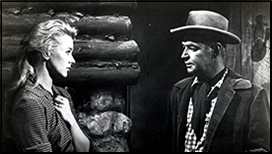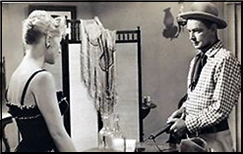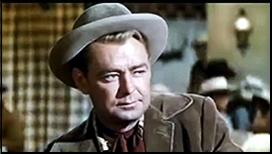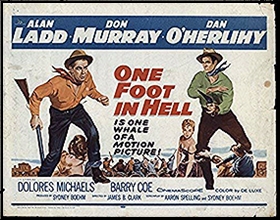Tue 2 Apr 2019
Mike Nevins on Mystery Writer JOHN ROEBURT, Part Three.
Posted by Steve under Authors , Columns[3] Comments
by Francis M. Nevins
Two of my recent columns (here and here) have been devoted to a once well-known but now largely forgotten writer named John Roeburt. This month is my third on the subject. And my last.
Except for EARTHQUAKE (Random House, 1959), the mainstream novel supposedly co-authored by vaudeville/TV comic Milton Berle, all of Roeburt’s books during his last five years of creative life were paperback originals. THEY WHO SIN (Avon pb #T-321, 1959) and RUBY MacLAINE (Hillman pb #151, 1960) seem to have been sex-driven, and the title of THE MOBSTER (Pyramid pb #G566, 1960) speaks for itself.
During these years Roeburt also turned out three media tie-in novels. THE UNHOLY WIFE (Avon pb #T-169, 1957) was based on the movie of the same name (RKO/Universal, 1957), which was directed by John Farrow and starred Diana Dors, Rod Steiger and Tom Tryon. As chance would have it, Steiger also starred in AL CAPONE (Burrows-Ackerman/United Artists, 1959), which was directed by Richard Wilson and featured Fay Spain and James Gregory. Roeburt’s novelization of the script (Pyramid pb #G405, 1959) followed soon after the movie’s release. His third and last effort of this sort was SING OUT, SWEET HOMICIDE (Dell pb #K105, 1961), which was based on the Warner Bros. TV series THE ROARING TWENTIES.
That paperback marked the end of Roeburt’s career as a novelist. But before fading away he did crank out three quickie nonfiction books for softcover publication. GET ME GIESLER (Belmont pb #L92-536, 1962) was a biography of celebrity criminal defense lawyer Jerry Giesler, the Johnnie Cockroach of his generation.
The subject of SEX-LIFE AND THE CRIMINAL LAW (Belmont pb #L92-560, 1963) is clear from the title. THE WICKED AND THE BANNED (Macfadden pb #60-147, 1963) had to do with books like LADY CHATTERLEY’S LOVER and TROPIC OF CANCER that were the subjects of obscenity prosecutions. I haven’t read this volume and can’t recall ever seeing a copy, but I feel safe in suggesting that anyone interested in the topic should turn instead to Charles Rembar’s THE END OF OBSCENITY (HarperCollins, 1986) or Edward DeGrazia’s GIRLS LEAN BACK EVERYWHERE: THE LAW OF OBSCENITY AND THE ASSAULT ON GENIUS (Random House, 1991).
Those books were Roeburt’s last. As in CITIZEN KANE, let’s go back and explore our subject’s beginnings.
After graduating from college—and from law school, if he ever went there—he held a variety of jobs. Apparently he drove a cab for a while, as one might have guessed from his three Jigger Moran novels, and worked in a few antique shops, making use of that setting in the second Moran exploit, THERE ARE DEAD MEN IN MANHATTAN (1946). His career as a radio writer came about as a result of his connection with one of the medium’s top producer-directors.
Himan Brown (1910-2010) graduated from both Brooklyn College and Brooklyn Law School, although he never practiced law and never took the bar exam. In 1927, while still a student, he began reading poetry over a New York radio station and was soon hired for acting jobs that called for Jewish dialect. His earliest success as a producer-director was MARIE, THE LITTLE FRENCH PRINCESS (CBS, 1933-35), the network’s first daily soap opera.
After several years doing soaps and action thrillers like DICK TRACY and FLASH GORDON, Brown created his first well-remembered series, INNER SANCTUM, a mystery-horror anthology show that ran on various networks between early 1941 and late 1952. For that series and others—including ADVENTURES OF THE THIN MAN, BULLDOG DRUMMOND, COUNTERSPY and THE FALCON—he needed a stable of writers, and among the literary workhorses who wound up in that stable was Roeburt.
Exactly which Brown shows he worked on and how many scripts he wrote for each remains unknown, but by the mid-1940s he was so well established in the field of radio crime drama that he got tapped to write an article on the subject for a major magazine (“Bloody Murder on the Airwaves,†Esquire, September 1945).
The earliest scripts known to be by Roeburt date from late 1947, and he turned out around two dozen for INNER SANCTUM between then and 1951, as well as three adventures of THE SHADOW. For one of Brown’s final radio series—BARRIE CRAIG, CONFIDENTIAL INVESTIGATOR (NBC, 1951-55, starring William Gargan)—he wrote at least 32 episodes.
Among the less successful Brown shows he worked on were TALES OF FATIMA (CBS, 1949, starring Basil Rathbone), THE AFFAIRS OF PETER SALEM (Mutual, 1949-53), and THE PRIVATE FILES OF REX SAUNDERS (NBC, 1951, starring Rex Harrison).
All this radio work didn’t keep Roeburt from dipping his toes gingerly in the Hollywood ocean. His earliest movie credit was JIGSAW (Tower/United Artists, 1949), starring Franchot Tone and Jean Wallace. Tone played crusading Assistant D.A. Howard Malloy, who runs afoul of an extremist group while investigating a series of murders. Fletcher Markle directed from a screenplay by himself and Vincent McConnor, based on an original story (perhaps a radio play?) by Roeburt.
A few years later he became involved with two projects for independent producers Edward J. and Harry Lee Danziger and director Edgar G. Ulmer (1904-1972), a wild talent who’s best known as the master of ultra-low-budget film noir. Roeburt however wasn’t involved with any of the director’s movies in that category. His first and only screenplay for an Ulmer film (from an original story by George Auerbach) was the Runyonesque ST. BENNY THE DIP (Danziger/United Artists, 1951), starring Dick Haymes, Nina Foch, Roland Young and Lionel Stander.
Roeburt received screen credit for additional dialogue on Ulmer’s Arabian Nights farce BABES IN BAGDAD (Danziger/United Artists, 1952), which starred Paulette Goddard, Gypsy Rose Lee, Richard Ney and John Boles. His work for the Danziger brothers also led, as we’ll see, to his being hired to write scripts for two of their TV series a few years later.
His final screenplay was for one of the most obscure movies I’ve ever heard of. DEAD TO THE WORLD (National Film Studios/United Artists, 1961) was based on Edward Ronns’ novel STATE DEPARTMENT MURDERS (Gold Medal pb #117, 1951) and was directed by Nicholas Webster. In the leading roles were the immortal Reedy Talton and Jana Pearce. I dare you to find that pair in your reference books!
As radio faded away and was replaced in the role of America’s home entertainment medium by TV, Roeburt did his best to go with the flow, but with how much success remains (dare I say it?) a mystery. Among the sparse TV writing credits for him documented by the Internet Movie Database, the earliest was the original story for “The Long Count†(FOUR STAR PLAYHOUSE, CBS, March 25, 1954), which starred Frank Lovejoy as McGraw, a PI with no first name.
A few years later McGraw became protagonist of his own series (NBC, 1957-58), which Roeburt wasn’t involved with. It was also in 1954 that the connection with Himan Brown led to Roeburt’s writing at least four scripts for the short-lived syndicated televersion of the INNER SANCTUM series.
The connection with the Danziger brothers also paid off for him when they hired him to write for two of their series which originated in England but were also seen in the U.S.: THE VISE (1955-59), which for most of its run starred Donald Gray as one-armed British PI Mark Saber, and THE CHEATERS (1959-61), with John Ireland as London-based insurance investigator John Hunter.
Between series for the Danzigers, Roeburt worked at the position which first brought him to my attention, as story editor and occasional scriptwriter for NBC’s THE FURTHER ADVENTURES OF ELLERY QUEEN (1958-59), a 60-minute live series. George Nader starred as EQ, with Les Tremayne playing Ellery’s father, Inspector Richard Queen.
Credits for this short-lived series are hard to come by. The Internet Movie Database lists nothing, and I have far fewer than I’d like to have. As story editor for the series Roeburt was almost certainly responsible for the decision to buy TV rights to novels by a number of other authors—including Hillary Waugh, Edgar Box (Gore Vidal), Harold Q. Masur and William P. McGivern—and yank out their continuing characters like Box’s Peter Sargeant and Masur’s Scott Jordan so that EQ in the person of George Nader could be shoehorned into the continuity.
Roeburt is not known to have done any of these scripts himself but he did write the TV adaptation of the 1950 Queen novel DOUBLE, DOUBLE (November 14, 1958). The basis of one EQ episode (December 26, 1958) was Roeburt’s own 1954 novel THE HOLLOW MAN, adapted by Howard Rodman and with Nader implausibly taking the place of Roeburt’s tough cop Johnny Devereaux. The cast included Frank Silvera, Whitney Blake, Murvyn Vye and Wesley Lau.
Two other episodes were allegedly based on Roeburt material. In “Four and Twenty—To Live†(December 12, 1958; script by Robert E. Thompson), Ellery is confronted by a young woman with a gun who demands that he phone the governor and request a stay of execution for her condemned father. And “The Jinn City Story†(January 9, 1959; script by Nicholas E. Baehr)starts out with Ellery’s plane forced by heavy fog to make an emergency landing at a small-town airport where he’s approached by a strange old man who asks him to clear someone falsely accused of murder. Featured in the cast were Peggie Castle, Vanessa Brown and Brian Keith.
Neither of these plots sound like any Roeburt novel I’ve read, although they might of course have come from original stories or radio plays. When the series moved from New York to Hollywood and from live to tape, with Lee Philips replacing Nader as EQ, Roeburt apparently declined to go along for the ride. There’s a character named Amos Roeburt in one of the Philips episodes but that’s hardly sufficient evidence that John was involved with the show’s second incarnation, which survived only a few months.
As far as I can tell, Roeburt did not appear in print or any other medium after 1963. Aside from a screenplay based on his 1958 novel THE CLIMATE OF HELL, copyrighted in August 1969 but never produced, how he occupied his time between the year of the Kennedy assassination and his own death remains unknown. Perhaps he’d saved enough money not to have to work anymore.
We do know that he was prosperous enough to maintain a summer home on Fire Island, where in 1972 he died. Anyone interested in pursuing Roeburt more deeply than I’ve done in these columns will find his papers at Boston University’s Howard Gotlieb Archival Research Center.
While working on this column I discovered to my surprise and delight that my copy of Roeburt’s movie novelization AL CAPONE, which I probably had never opened since buying it decades ago, was graced by an inscription in the hand of Roeburt himself—an inscription which I hope you can read below. Whether Roeburt was referring just to this one book as “horrendous†or was writing off his entire literary output remains unknown.
As I hope this column and my earlier ones have shown, what he contributed to the genre we love is well worth at least a modicum of attention.




